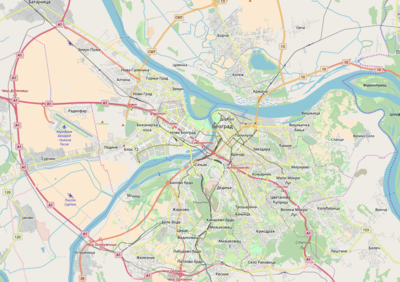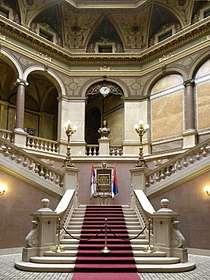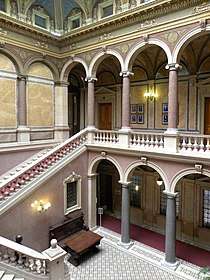National Bank Building, Belgrade
The National Bank building in Belgrade (Serbian: Зграда Народне банке у Београду, romanized: Zgrada Narodne Banke u Beogradu) is a monument of great importance, located in Belgrade, Serbia, at 12 King Petar St.[1]
| National Bank Building | |
|---|---|
Зграда Народне банке | |
View from outside | |
 | |
| General information | |
| Town or city | Belgrade |
| Country | Serbia |
| Coordinates | 44°49′07″N 20°27′14″E |
| Construction started | 1889 |
| Completed | 1890 |
| Opened | 15 March 1890 |
The establishment of the National Bank
The establishment of the Privileged National Bank of the Kingdom of Serbia was a long process consequent on the development of the economy, currency and other financial institutions, as well as the needs of economic and political emancipation of the Kingdom of Serbia. The Bank was formally launched after the adoption of the Law on the National Bank, 12 December 1882, which was confirmed by king Milan Obrenovic on 6 January 1883. Under this law, the Bank was established as a privileged institution (for the next 25 years in the form of a joint stock company), with an initial capital of 20 million dinara, and it was envisaged that its activities would be conducted under the control of the state. Officially, the Bank began operations on 1 June 1884. On that date, the bank leased space taken in Knez Mihajlo no. 38 (now No. 50), at the house of Hristina Kumanudi.[2]
Construction of the building
As its temporary accommodation was inadequate, land was purchased for the construction of a new building in 1886 on the corner of Dubrovacka and Prince Lazar streets.

In 1887, a draft plan for the new building was adopted, drawn up by two architects employed in the Ministry of Construction. However, the Board of Directors decided to assign project development to Konstantin Jovanović, then already affirmed architect, and son of a lithographer Anastas Jovanović. The Bank project was also his first job in Belgrade. Construction of the building was entrusted to contractors Jirasek and Kraus from Szeged. The work lasted from 1889 until its official completion on 15 March 1890. The importance of the new building was reflected in the award to Konstantin A. Jovanović in 1890 of the Order of St. Sava, class III. The bank's report for 1890 said: "...the Bank has a house of which she can be proud of, as can our capital, which she serves to ornament". Great credit goes to architect Kosta Jovanović who developed the plans and under whose supervision the building was constructed.[2]
After World War I, the Privileged National Bank of the Kingdom of Serbia became the National Bank of the Kingdom of Serbs, Croats and Slovenes. Between 1922–25, the bank building was extended to cater for its space requirements, to fill the entire area of the city block, in the form of an irregular pentagon. Jovanović again carried out the extension, in a style consistent with the older part of the building. It is a closed block with an internal atrium courtyard, and has been preserved to date. Jovanović modelled the building stylistically on the architecture of late-Renaissance palaces of 16th-century Italy. It also appears to be influenced by Jovanović' professor and prominent Viennese architect Gottfried Semper.[2]
Architecture
Jovanović's immediate models were Palazzo Farnese in Rome, designed by Antonio da Sangallo the Younger and Michelangelo (1513, and 1534–46), and Semper's mid-19th-century Oppenheim Palace in Dresden.
The Bank building best embodies a characteristic feature of Jovanović's concept of architectural design: variation on a Renaissance façade theme combined with an eclectic approach obvious in the use of elements of Baroque architectural decoration.[3] The remarkable articulation of this concept makes the National Bank Jovanović's most important work and one of the most important works of academism in Serbian architecture.[4]
Exterior design
The elevations show a tripartite horizontal division typical of academism. The zones are clearly defined by the contrast between the rusticated lower and calmer upper zones, separated by a prominent stringcourse. The heavy and monolithic rustication of the basement and ground-floor zone, tempered by the regular rhythm of arch-headed windows, is a clear reference to the Florentine 15th-century palazzo. The monotony of the ground floor is broken by formal entrances facing Kralja Petra and Cara Lazara streets. The upper zones display less restraint. The strict hierarchy of the first-floor composition pattern is given a more dynamic edge by alternating differently topped windows and accentuating the imposing windows above the entrances. The second-floor zone, simplified by a row of less ornate window openings, is surmounted by a protruding cornice and a balustraded parapet.
Interior design
The artistically rich design of interior spaces includes a large number of functional and decorative arts and crafts objects, which form an integral part of the architecture of the building. Particular emphasis was placed on the design of functional nodes: the vestibule in the earlier part of the building and the counter hall in the later one. Being accessible to the public, these spaces were elaborately decorated in the neo-Renaissance style, with a composition pattern based on contrasts between full and empty surfaces, and calm monochrome and vibrant polychrome details, on the generous use of floral ornamentation, and on the alternation of different materials.

The general impression of luxury and monumentality of the interior is reinforced by an ensemble of decorative wall painting, one of the best preserved and most prestigious created in the early 20th century. It followed European trends of the time and was conceived as fully subordinate to architecture. This type of decorative painting is understandably devoid of the painter's personal touch and probably follows a pattern of central-European origin. The painted decoration of the part of the building constructed in 1925 shows the same pattern, iconography and style as the older part. Its iconography displays a compilation of motifs based on free quotation from various mythologies and artistic traditions. The symbolism of the decoration, through the motifs of cornucopias, sphinxes, gryphons and, the central one, Mercury, clearly refers to the function of the building, conveying the idea of success, affluence and prosperity. To be singled out in terms of artistic merit is the allegorical bust of Serbia, a work of the sculptor Đorđe Jovanović originally intended for the monument to the heroes of the Battle of Kosovo in Kruševac. Set up in the vestibule of the older part of the building, the bust underscores the national character of the establishment. Until the Second World War the interior was adorned with the portraits of all previous governors of the National Bank, oils on canvass painted by Uroš Predić.
The National Bank building is representative both of contemporary European trends in the style of academism, and of the work of Konstantin Jovanović, Serbia's best connoisseur of academic architecture. The architect's distinctive interpretation and the institutional importance of the National Bank make this building a remarkable testament to the social aspirations and economic and architectural achievement of the Kingdom of Serbia and the Kingdom of Serbs, Croats and Slovenes. It was designated a heritage property[5] of outstanding significance in 1979.
See also
References
- Завод за заштиту споменика културе града Београда (in Serbian). Office of the Republic for Protection of Cultural Monuments - Belgrade, Retrieved 18 June 2014.
- http://beogradskonasledje.rs National Bank building, Retrieved 18 June. 2014.
- О архитектури Народне банке у Београду: Љиљана Бабић, Живот и рад архитекте Константина А. Јовановића, посебни део, ЗАФ VI-2, Београд 1961; Љиљана Бабић, Живот и рад архитекте Константина А. Јовановића, општи део, ЗАФ V-6 1960; Љубомир Никић, Из архитектонске делатности Константина Јовановића у Београду, ГГБ XXIII, Београд 1976. 127-130; Др. Дивна Ђурић Замоло, Градитељи Београда 1815-1914, Београд 1981. 55; Гордана Гордић, Палата Народне банке, Наслеђе II, Београд 1999. 85-94; Вера Павловић-Лончарски, Гордана Гордић, Архитект Константин А. Јовановић, Београд 2001; Александар Кадијевић, Естетика архитектуре академизма (XIX-XX век), Београд 2005. 314, 315, 354; Иван Клеут, Градитељски опус Константина Јовановића у Београду, ГГБ LIII, 2006. 214-249; Документација Завода за заштиту споменика културе града Београда.
- Завод за заштиту споменика културе града Београда, 10.10.2013, каталози 2012, Народна банка у Београду, аутор, Александар Божовић.
- Завод за заштиту споменика културе града Београда, 10.10.2013, Каталог непокретних културних добара на подручју града Београда, Народна Банка
Literature
- Ljiljana Babić, “Život i rad arhitekte Konstantina A. Jovanovića” (general part), ZAF V-6 (1960);
- Ljiljana Babić, “Život i rad arhitekte Konstantina A. Jovanovića” (special part), ZAF VI-2 (1961);
- Ljubomir Nikić, “Iz arhitektonske delatnosti Konstantina Jovanovića u Beogradu”, GGB XXIII (1976), 127–130;
- Divna Djurić Zamolo, Graditelji Beograda 1815–1914 (Belgrade 1981), 55;
- Milan Šćekić, Konstantin Jovanović arhitekt, Catalogue of K. Jovanović's Legacy from the Belgrade City Museum collections (Belgrade 1988);
- Aleksandar Kadijević, Estetika arhitekture akademizma (XIX–XX vek) (Belgrade 2005), 314, 315, 354;
- Bojan Radovanović, 110 godina Narodne banke 1884–1994 (Belgrade 1994);
- Gordana Gordić, “Palata Narodne banke”, Nasledje II (1999), 85–94;
- Ivan Kleut, “Graditeljski opus Konstantina Jovanovića u Beogradu”, GGB LIII (2006), 214–249
CHPIB Documentation.